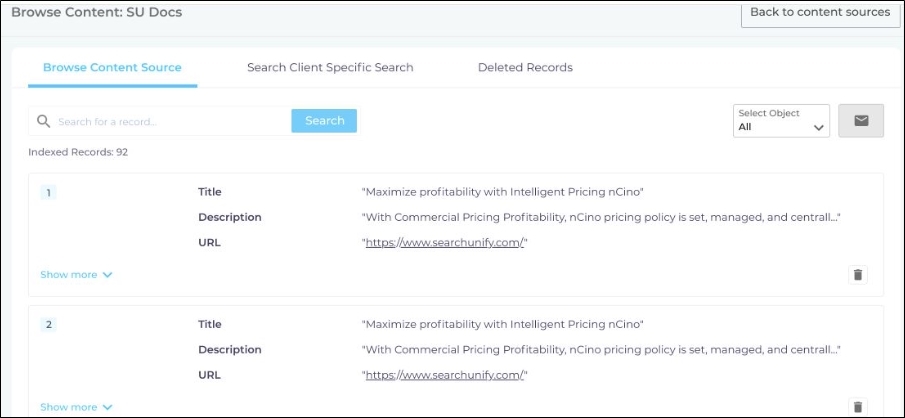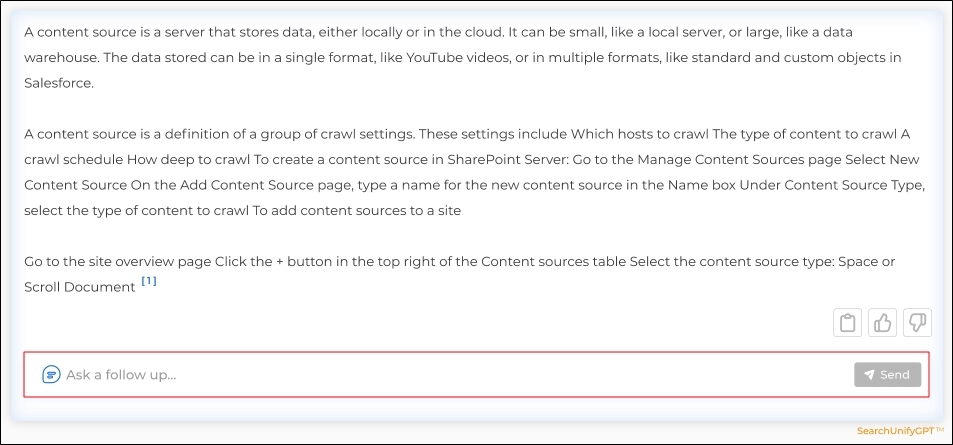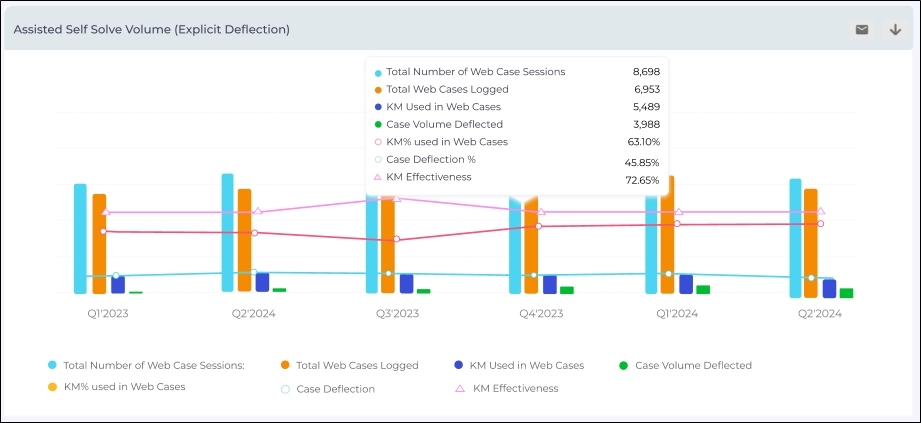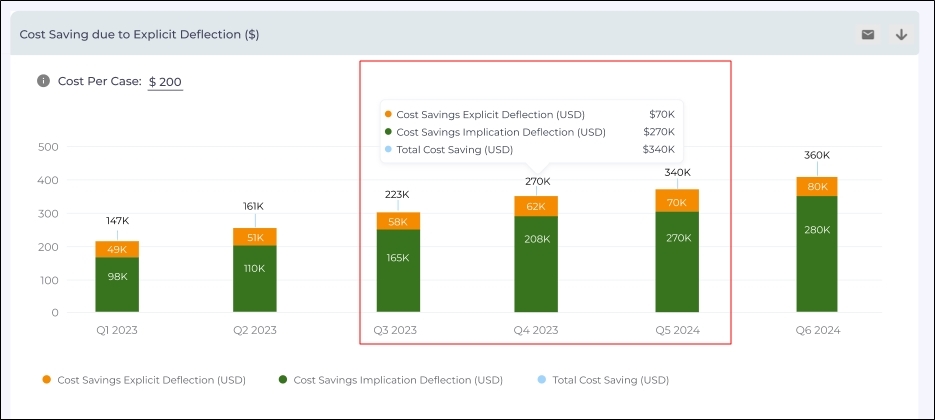Release Notes: SearchUnify Q4 '24
We’re delighted to unveil the fourth quarterly release of 2024 (Q4 ‘24) showcasing a range of new features and improvements designed to enhance ease of use. This release is now available for SearchUnify users, offering exciting new capabilities and advancements.
Key Highlights
The key highlights of the Q4 release include:
-
Leadership Dashboard – The Leadership Dashboard provides a clear view of insights and trends, giving Business Leaders an overall picture of how the product is performing. By bringing together key metrics, it helps evaluate support strategies, track self-service performance, measure ROI, and monitor progress—all in one place. It’s designed to guide leaders in making informed decisions and driving better business outcomes.
It now has two new reports:
-
Assisted Self-Solve Volume (Explicit Deflection) – This report offers decision makers the essential metrics, including assisted-solve volumes, case deflection rates, and performance trends for knowledge articles and key insights, such as the Case Volume Deflected and Deflection%, highlight the direct impact of the knowledge in reducing the case volume. This knowledge effectiveness metric clearly measures how well your knowledge base performs in preventing cases.
-
Cost Savings due to Explicit Deflection ($) – This report highlights the financial impact of the knowledge, showing ROI from implicit and explicit case deflection based on the cost per case. These metrics reveal the direct financial benefits of your self-service and knowledge efforts and you can see the real return on your investment with SearchUnify.
-
-
Follow-Up Queries in SearchUnifyGPT™ – Follow-up query support is now available in SearchUnifyGPT™, enabling users to build on previous searches and refine broad queries into precise answers. This conversational capability is exclusive to the SUVA Agentic Interface and is not available in the standard search experience. Users can continue the interaction seamlessly within the chat, powered by enhanced SUVA Agentic AI experience.
-
Khoros Aurora as a new Content Source – Aurora delivers a streamlined, feature-rich solution for community management and customer engagement with improved usability and design. Organizations using Khoros’ Aurora platform can index their content in SearchUnify.
-
New Khoros Aurora Search Client – SearchUnify now provides a dedicated Search Client for Khoros Aurora, making community content easily searchable and accessible, improving case deflection and boosting customer satisfaction.
-
Manage Indexed Records – Admins can now browse indexed records at the Content Source level, apply filters for refined searches, and delete records directly from the index.
Content Sources
Khoros Aurora Platform Content Source
Khoros is a well-known platform for hosting business communities, with over 20 years of experience in the industry. Recently, it launched its updated community platform, Aurora. SearchUnify provides out-of-the-box support for Aurora, enabling it to crawl messages, threads, and other content from your Khoros Aurora community and make them easily searchable.
More information: Use Khoros Aurora as a Content Source
Manage Indexed Records in Content Source
With this new feature, admins can easily access and manage indexed records at the Content Source level. They can browse records, search for specific entries, and apply filters to refine the results. The data is presented in a clear and organized format, making it simple to review. This functionality helps admins efficiently manage, delete, and organize records. Additionally, records can be deleted directly from the index.
-
The Browse Content Source feature allows SearchUnify admins to view and manage indexed records. Admins can delete records, which removes them from the SearchUnify index but not from the content source itself. Additionally, admins have the option to exclude deleted records from being re-indexed during future crawls.
-
Search Client Specific Search feature enables SearchUnify admins to view and manage indexed records linked to a specific search client. Deleted records are removed only from the associated search client but may reappear after the next crawl.
-
Deleted Records feature stores documents removed by admins in the Browse Content Source tab. Admins can restore these deleted documents back into the index with a single click.
Fig: Snapshot of Indexed Records in the Content Source.
More information: Live Docs and Temporary Docs, Manage Indexed Records in "Browse Content Source", Search Client Specific Search, and Deleted Records
Search Clients
Khoros Aurora Platform Search Client
SearchUnify now offers a dedicated Search Client specifically designed for Khoros Aurora, enabling users to find information quickly and efficiently. You can use the Khoros Aurora search client to make the messages, thread, and other content on your community searchable and easily accessible. This in turn, helps improve case deflection rates and boosts customer satisfaction scores.
More information: Install a Search Client in Khoros
Ask Follow-Up Queries on SearchUnifyGPT™ Responses
The follow-up query capability in SearchUnifyGPT™ is exclusive to the SUVA Agentic Interface and allows users to refine their searches by building on the context of previous queries and interactions. This enables a conversational experience where users can start with a broad query and progressively narrow down results using specific keywords and phrases for more correct answers. For example, if a user searches for a Leadership Dashboard, they can follow up by asking which reports are available in it.
NOTE. Access to follow-up queries in SearchUnifyGPT™ is available only to users with an active SUVA subscription. This feature is included as part of the enhanced conversational experience enabled by SUVA Agentic Interface and is not available in the standard search offering.
Fig. The follow-up query dialog on SearchUnifyGPT response.
More information: About SearchUnifyGPT™
Search Analytics
New Reports in Leadership Dashboard
The Leadership Dashboard now includes two new reports designed to improve insights into case deflection trends and enhance cost savings – Assisted Self-Solve Volume (Explicit Deflection) and Cost Savings due to Explicit Deflection ($).
Assisted Self-Solve Volume (Explicit Deflection)
The Assisted Self-Solve Volume (Explicit Deflection) report, providing business leaders with critical metrics such as assisted-solve volumes, case deflection rates, and the performance of knowledge over time. This report is available in the Admin Panel > Analytics > Leadership Dashboard > Business on Page.
Fig. Snapshot of Assisted Case Solve Volume (Explicit Definition) report with quarterly data.
This report evaluates the performance of the knowledge in helping you assess its effectiveness in:
-
Reducing support case volumes
-
Improving customer self-service
More information: Assisted Self Solve Volume (Explicit Deflection)
Cost Savings due to Explicit Deflection ($)
The Cost Savings from Explicit Deflection ($) report provides a comprehensive overview of savings generated through the deflection of customer support interactions through self-service. The calculations are based on the selected search client and rely on the cost per case value provided by a SearchUnify admin, which is entered in the Cost per Case field.
This report is available in the Admin Panel > Analytics > Leadership Dashboard > Business on Page.
Fig. Snapshot of Cost Savings due to Explicit Deflection ($) report.
More information: Cost Savings due to Explicit Deflection ($)
Apps
Agent Helper
Agent Helper is now available in a brand-new avatar and many GenAI capabilities. The upgraded app offers a new user interface and experience along with new functionalities, including Case Timeline, Case Summary, Response Assist, etc.
-
Case Timeline offers agents a clear overview of the user's search history, case interactions, and key events, enabling quick understanding and efficient responses. By minimizing the time spent comprehending each interaction, agents can prioritize cases and tasks, enhancing productivity. With insights into sentiment trends at both the overall and interaction levels, agents can make informed decisions, focusing on high-priority issues and forecasting potential escalations. This approach not only boosts efficiency but also improves customer satisfaction and resolution outcomes.
-
Case Summary, our AI-powered summarization tool, automatically distills case details into clear, concise summaries. By analyzing subject lines, descriptions, and comments, summaries provide agents with a quick overview of each case, saving them valuable time and they can begin work on providing a resolution to the case. Additionally, case summaries help reduce training and onboarding time, offering managers the actual examples of effective case handling for new agents.
-
Response Assist is a feature that leverages large language models (LLMs) and accelerates case resolution by generating quick,relevant responses from your knowledge bases, allowing agents to address customer inquiries more efficiently. It reduces redundancy by offering tailored responses, ensuring customers receive relevant, unique information every time. Additionally every response generated by Response Assist is based on the case journey situation paired with a set tone of the template.
More information: Agent Helper Actions: Using AH in Salesforce Service Console and Agent Helper Overview: Using AH in Salesforce Service Console
Boosting Quality with Agent Helper's User Feedback system
Agent Helper now includes a feedback mechanism that allows users to rate Case Timeline, Case Summary, and the responses generated by Response Assist with a thumbs up or thumbs down. This feature collects user satisfaction data, helping to improve the quality and accuracy of the responses provided by the product.
Agent Helper Feedback Analysis
The user feedback analysis is compiled and presented to the admins in Analytics > Agent Helper Analytics > Feedback Analysis.
The Feedback Analysis report shows all the feedback shared by the support agents on a case. This report is helpful for the support managers and admins to understand the impact Agent Helper is having in the daily lives of their support agents. Also, it helps them to get a perspective of the most useful Agent Helper features.
More information: Agent Helper Analytics > Feedback Analysis
Agent Helper Adoption Metrics
The Agent Helper Adoption Metrics report enables company leaders to monitor product adoption by providing a visual graph of feature utilization for informed investment decisions. This report provides key metrics for decision-makers to assess support reps' adoption, usability, and ROI of Agent Helper. It also highlights the metrics to assess how Agent Helper accelerates case resolution.
This report Agent Helper Adoption Metrics analyzes data from the last six quarters (presented either as monthly or quarterly), segmented into key metrics: Total Closed Case Volume, Closed Case AH Adoption, Response Assist Adoption, Intelligent Swarming Adoption, and Case Summarization Adoption.
Fig. Snapshot of Agent Helper Adoption Metrics report in Agent Helper.
More information: Agent Helper Analytics > Agent Helper Adoption
Average Time to First Response Metrics
The Average Time to First Response Metrics report analyzes data from the last six quarters, segmented into three key metrics:
-
Total Closed Case Volume: Displays the number of cases closed within selected months or quarters.
-
Average Time to First Response (Days): Shows average days taken by agents for initial case responses across all channels.
-
Response Time with Agent Helper (Days): Tracks average response time (in days) when agents use the Agent Helper console features.
Fig. Snapshot of Average Time to First Response Metrics report in Agent Helper.
More information: Average Time to First Response Metrics
Case Escalation Metrics report in Agent Helper Adoption
A new Case Escalation Metrics report is added. The Case Escalation Metrics report helps the leadership analyze the efficiency of their support to manage the customer cases.
This report is available at Analytics > Agent Helper Analytics > Agent Helper Adoption Metrics. This report highlights the trend of case escalation over time and shows the number of escalated cases against the number of closed cases in the selected duration.
More information: Case Escalation Metrics
Other Updates
Deprecated Reports and Features
Some of the reports have been deprecated as listed below:
“Next Best Action” report
The “Next Best Action” report on the Home page in SearchUnify instances is no longer supported and permanently removed with the Q4 ‘24 release.
“KCS Articles” report
The “KCS Articles” report, introduced in Mamba ‘22 to help admins identify frequently attached articles to cases, is no longer supported. Since Knowbler is now a separate product, admins can find all Knowledge-Centered Support analytics reports within Knowbler. This report is removed from the SearchUnify instances with this release.
“Template” Tab
After four years of supporting users in customizing search client appearances, the Template tab is no longer available from Q4 ‘24 release. Originally introduced in Mamba ‘20, the Template tab is replaced by a more powerful Search Client Editor, which enables admins to customize almost all components of their search clients.
Known Issue
The Crawl Logs screen currently displays 'Successfully completed crawling’, even when some documents are not indexed due to invalid attachment fields. This issue will be fixed in the next release and the Crawl Logs screen will display an error message along with the URLs of the documents that were not indexed.







